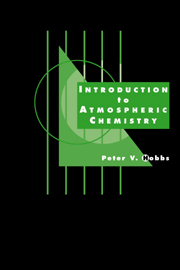Book contents
- Frontmatter
- Contents
- Preface
- 1 Evolution of the Earth's atmosphere
- 2 Half-life, residence time, and renewal time of chemicals in the atmosphere
- 3 Present chemical composition of the atmosphere
- 4 Interactions of solar and terrestrial radiation with atmospheric trace gases and aerosols
- 5 Sources, transformations, transport, and sinks of chemicals in the troposphere
- 6 Atmospheric aerosols
- 7 Cloud and precipitation chemistry
- 8 Tropospheric chemical cycles
- 9 Air pollution
- 10 Stratospheric chemistry
- Appendix I Exercises
- Appendix II Answers to exercises in Appendix I and hints and solutions to the more difficult exercises
- Appendix III Atomic weights
- Appendix IV The International System of Units (SI)
- Appendix V Some useful numerical values
- Appendix VI Suggestions for further reading
- Index
3 - Present chemical composition of the atmosphere
Published online by Cambridge University Press: 05 June 2012
- Frontmatter
- Contents
- Preface
- 1 Evolution of the Earth's atmosphere
- 2 Half-life, residence time, and renewal time of chemicals in the atmosphere
- 3 Present chemical composition of the atmosphere
- 4 Interactions of solar and terrestrial radiation with atmospheric trace gases and aerosols
- 5 Sources, transformations, transport, and sinks of chemicals in the troposphere
- 6 Atmospheric aerosols
- 7 Cloud and precipitation chemistry
- 8 Tropospheric chemical cycles
- 9 Air pollution
- 10 Stratospheric chemistry
- Appendix I Exercises
- Appendix II Answers to exercises in Appendix I and hints and solutions to the more difficult exercises
- Appendix III Atomic weights
- Appendix IV The International System of Units (SI)
- Appendix V Some useful numerical values
- Appendix VI Suggestions for further reading
- Index
Summary
Units for chemical abundance
Before discussing the chemical composition of the atmosphere, we need to describe the various units that can be used for expressing the amounts (or abundances) of chemicals in the atmosphere.
The most common unit for expressing the abundance of gases in air is mixing ratio by volume that is, the fraction of the volume of the air occupied by a gas. Depending on the magnitude of the mixing ratio, the most convenient units can be percent by volume, parts per million by volume (ppmv),parts per billion by volume (ppbv), or parts per trillion by volume (pptv), where, 1 ppmv = 1 unit of volume per 106 units (or 10−6), I ppbv = 1 unit of volume per 109 units (or 10−9), and 1 pptv = 1 unit of volume per 1012 units (or 10−12). Note that we use the American definitions of billion (109) and trillion (1012). It is very convenient to express the abundance of a gas as a mixing ratio by volume, because, from the gas equation, we know that the volumes occupied by different gases at the same temperature and pressure are proportional to the numbers of molecules of the gases.
- Type
- Chapter
- Information
- Introduction to Atmospheric Chemistry , pp. 21 - 32Publisher: Cambridge University PressPrint publication year: 2000

